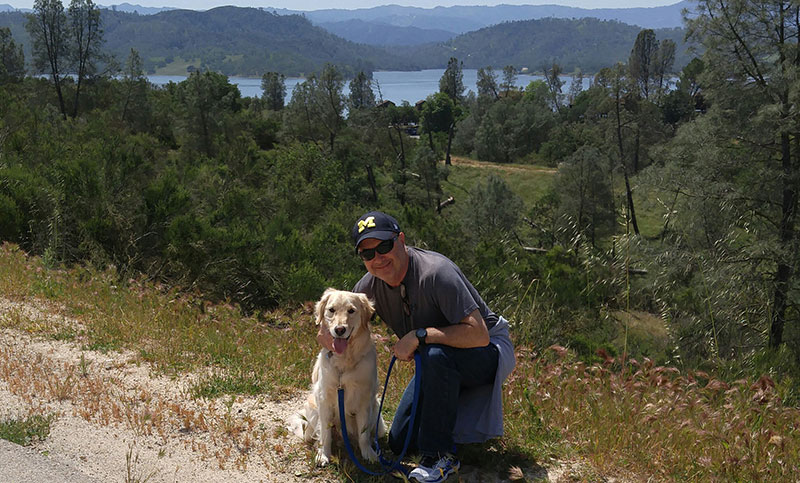A lot changed during the Covid-19 pandemic. More people started working from home and fitness routines were interrupted (and maybe not resumed). Then, the early sunsets of the winter months kept us all indoors.
Now that we’re free to leave our houses — and the sunny weather makes it nicer to be outdoors — it’s time for extra-long dog walks!
Like many other dog owners, my golden retriever, Beau, and I have logged more miles together since Covid than ever before.
Foot and ankle injuries are on the rise, to say the least
I am finding, like many of my podiatrist colleagues, a sort of a pandemic of foot pain due to “overuse injuries,” due to repetitive motions causing excessive strain on certain tissues within the body.
I am seeing lots of foot problems. These foot injuries and ankle injuries include ankle pain and ankle sprains as well as a lot of Achilles tendonitis, sore calf muscles, plantar fasciitis, lower leg and heel pain, and sports injuries.
The feet, ankles, and legs are very susceptible to an increased risk of injury due to their need to bear our weight. The most common injury is plantar fasciitis, but may also include shin splints, Achilles tendonitis, Posterior Tibial Tendinitis, Peroneal Tendinitis, plantar plate injuries in the forefoot, arthritis, and muscle strain can all be the results of overuse.
The bones in the feet and ankles as well as the tendons and ligaments that attach to them, need to react to stress and adapt in their construct when a change occurs. If too much stress occurs on the tissue before the tissue can adapt properly, then injury may occur.
Stress fractures, (also called a stress reaction or bone bruise) have increased dramatically in the past few months. They can be very painful, cause localized swelling redness, and warmth, and can come on quite suddenly. The metatarsals, just behind the toes, and the heel bone are particularly common locations.

The pandemic caused a rise in over-use injuries
An example of this is a friend of mine’s wife, Kathy, whom I have known for many years. She is a fitness buff, at the gym often doing cross-training. Suddenly, she found herself working from home with no place to work out, so she decided to try running again.
Her cardiovascular fitness is not a problem, but one night her husband calls me, to tell me Kathy’s heel is killing her, she is having swelling and weight-bearing hurts like crazy: What should they do?
We did X-rays and sure enough, she had a stress fracture in her heel bone. Five weeks in a cast boot fixed the problem, but Kathy’s story is not unusual these days.
Bone injuries generally require rest to heal, no medications or therapies generally work, but the good news is they do heal predictably and don’t often recur.
Soft tissue injuries, such as tendon problems or joint issues involving ligamentous structures are different in behavior. But, just like bone injuries, they can be caused by repetitive stress on the tissues greater than the ability of the tissues to adapt to the stress. They tend to be more gradual in onset and can become chronic if not treated properly.
Often the pain occurs after rest and “warm-up” during sports activities but can progress to constant pain, inflammation, acute injuries, and disability. There are numerous treatments for these types of injuries, but the best treatment is to avoid it in the first place. These include warm-up exercises, arch support with shoe inserts (orthotics), very good quality and not “worn out” running shoes, and taking things slowly to build up muscle strength.
Once this type of injury occurs and doesn’t respond to at-home treatments such as a few days’ rest, ice, or over-the-counter medications then it is time to visit the sports medicine specialist. Treatment may include pain management, physical therapy, massage therapy, taping, bracing, orthotics, or immobilization in a cast boot or fiberglass cast. Long term treatment may include regenerative medicine such as PRP or stem cell type therapy.
How to prevent overuse injuries
It is important to introduce change in your physical activity gradually and follow a fitness program that allows different kinds of stress on your body, giving roughly 48 hours of recovery.
When it comes to summer dog walking, you can walk your dog every day — maybe twice a day if they’re an active pup — just vary the routine! Fast and quick one day, slow and long the next. The right shoes are important, but you can alternate them as well. Mainly, have fun, stay fit, and love your dog!
Why choose University Foot and Ankle Institute for overuse injuries?
The UFAI success rate in curing running injuries, foot and ankle injuries, range of motion issues, ankle instability, bunion issues, flat feet, and many more are among the highest in the country. Over 99% of our patients return to full and unrestricted activity following our chronic ankle instability surgery and rehabilitation protocols.
If you’re experiencing foot and ankle problems, we’re here to help. Our nationally recognized foot and ankle surgeons offer the most advanced care and the highest success rates in the nation. We are leaders in the research and treatment of all foot and ankle conditions.
For more information or to schedule a consultation in the greater Los Angeles area, please call (877) 736-6001 or make an appointment now.
University Foot and Ankle Institute is conveniently located throughout Southern California with podiatry clinics in (or near) Santa Monica (on Wilshire Blvd.), Los Angeles, Beverly Hills, West Los Angeles, Sherman Oaks, and the San Fernando Valley, Manhattan Beach, and the South Bay, LAX, Westlake Village, Valencia, Santa Clarita, and Santa Barbara.
- Avoiding Foot and Ankle Overuse Injuries While Dog Walking - July 17, 2023
- What is Floating Toe Syndrome? - June 12, 2023
- Is there a link between gout and heart disease? Studies Say Yes - February 22, 2022